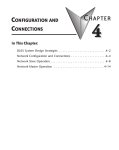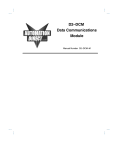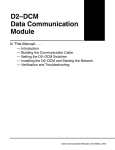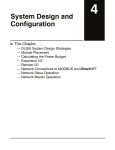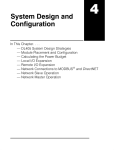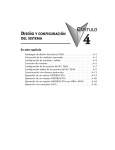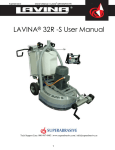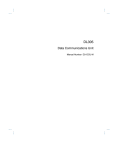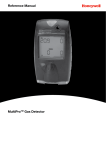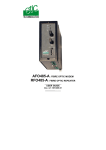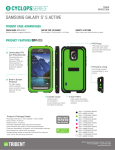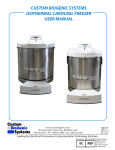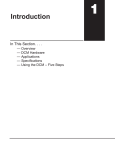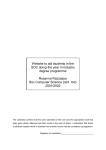Download D4--DCM - AutomationDirect
Transcript
D4--DCM Data Communications Module Manual Number D4-DCM-M WARNING Thank you for purchasing automation equipment from PLCDirectä. We want your new DirectLOGICä automation equipment to operate safely. Anyone who installs or uses this equipment should read this publication (and any other relevant publications) before installing or operating the equipment. To minimize the risk of potential safety problems, you should follow all applicable local and national codes that regulate the installation and operation of your equipment. These codes vary from area to area and usually change with time. It is your responsibility to determine which codes should be followed, and to verify that the equipment, installation, and operation is in compliance with the latest revision of these codes. At a minimum, you should follow all applicable sections of the National Fire Code, National Electrical Code, and the codes of the National Electrical Manufacturer’s Association (NEMA). There may be local regulatory or government offices that can also help determine which codes and standards are necessary for safe installation and operation. Equipment damage or serious injury to personnel can result from the failure to follow all applicable codes and standards. We do not guarantee the products described in this publication are suitable for your particular application, nor do we assume any responsibility for your product design, installation, or operation. If you have any questions concerning the installation or operation of this equipment, or if you need additional information, please call us at 1--800--633--0405. This publication is based on information that was available at the time it was printed. At PLCDirectä we constantly strive to improve our products and services, so we reserve the right to make changes to the products and/or publications at any time without notice and without any obligation. This publication may also discuss features that may not be available in certain revisions of the product. Trademarks This publication may contain references to products produced and/or offered by other companies. The product and company names may be trademarked and are the sole property of their respective owners. PLCDirectä disclaims any proprietary interest in the marks and names of others. Stage is a trademark of Koyo Electronics Industries Co., LTD. Texas Instruments is a registered trademark of Texas Instruments, Inc. TI, TIWAY, Series 305, Series 405, TI305, and TI405 are trademarks of Texas Instruments, Inc. Siemens and SIMATIC are registered trademarks of Siemens, AG. GE is a registered trademark of General Electric Corporation. Series One is a registered trademark of GE Fanuc Automation North America, Inc. MODBUS is a registered trademark of Gould, Inc. IBM is a registered trademark of International Business Machines. MS-DOS and Microsoft are registered trademarks of Microsoft Corporation. Windows is a trademark of Microsoft Corporation. OPTOMUX and PAMUX are trademarks of OPTO 22. Copyright 1997, PLCDirectä Incorporated All Rights Reserved No part of this manual shall be copied, reproduced, or transmitted in any way without the prior, written consent of PLCDirectä Incorporated. PLCDirectä retains the exclusive rights to all information included in this document. 1 Manual Revisions If you contact us in reference to this manual, be sure to include the revision number. Title: DL405 Data Communications Module Manual Number: D4--DCM--M Issue Date Effective Pages Description of Changes Original 1/94 Cover/Copyright Contents Manual History Preface 1-1 -- 1-26 A-1 -- A-9 Original Issue Rev. A 6/98 Entire Manual Manual Revisions Appendix A Downsize to spiral Rev. A Added DL305/405 Cross Reference 1 Table of Contents Introduction . . . . . . . . . . . . . . . . . . . . . . . . . . . . . . . . . . . . . . . . . . . . . . . . . . . . . . . . . . . . . . . . . . . . . . . . . Overview . . . . . . . . . . . . . . . . . . . . . . . . . . . . . . . . . . . . . . . . . . . . . . . . . . . . . . . . . . . . . . . . . . . . . . . . . Manual Layout . . . . . . . . . . . . . . . . . . . . . . . . . . . . . . . . . . . . . . . . . . . . . . . . . . . . . . . . . . . . . . . . . . . . DCM Hardware . . . . . . . . . . . . . . . . . . . . . . . . . . . . . . . . . . . . . . . . . . . . . . . . . . . . . . . . . . . . . . . . . . . Applications . . . . . . . . . . . . . . . . . . . . . . . . . . . . . . . . . . . . . . . . . . . . . . . . . . . . . . . . . . . . . . . . . . . . . As a DirectNET Interface . . . . . . . . . . . . . . . . . . . . . . . . . . . . . . . . . . . . . . . . . . . . . . . . . . . . . . . . . . As an Extra Communication Port . . . . . . . . . . . . . . . . . . . . . . . . . . . . . . . . . . . . . . . . . . . . . . . . . . . . As a Modbusâ Network Interface . . . . . . . . . . . . . . . . . . . . . . . . . . . . . . . . . . . . . . . . . . . . . . . . . . . . Specifications . . . . . . . . . . . . . . . . . . . . . . . . . . . . . . . . . . . . . . . . . . . . . . . . . . . . . . . . . . . . . . . . . . . Environmental Specifications . . . . . . . . . . . . . . . . . . . . . . . . . . . . . . . . . . . . . . . . . . . . . . . . . . . . . . . Operating Specifications . . . . . . . . . . . . . . . . . . . . . . . . . . . . . . . . . . . . . . . . . . . . . . . . . . . . . . . . . . . Using Your DCM -- Five Steps . . . . . . . . . . . . . . . . . . . . . . . . . . . . . . . . . . . . . . . . . . . . . . . . . . . . . 1 2 3 4 5 5 6 6 7 7 7 8 Building the Communication Cable. . . . . . . . . . . . . . . . . . . . . . . . . . . . . . . . . . . . . . . . . . . . . . . . . . . Consideration 1: Physical Configuration . . . . . . . . . . . . . . . . . . . . . . . . . . . . . . . . . . . . . . . . . . . . . . Consideration 2: Electrical Specification RS232C or RS422 . . . . . . . . . . . . . . . . . . . . . . . . . . . . . Consideration 3: Cable Schematics . . . . . . . . . . . . . . . . . . . . . . . . . . . . . . . . . . . . . . . . . . . . . . . . . . Consideration 4: Cable Specifications . . . . . . . . . . . . . . . . . . . . . . . . . . . . . . . . . . . . . . . . . . . . . . . . Consideration 5: Installation Guidelines . . . . . . . . . . . . . . . . . . . . . . . . . . . . . . . . . . . . . . . . . . . . . . Consideration 6: A Quick Test Cable . . . . . . . . . . . . . . . . . . . . . . . . . . . . . . . . . . . . . . . . . . . . . . . . . 9 10 11 12 16 16 19 Setting the DCM Switches . . . . . . . . . . . . . . . . . . . . . . . . . . . . . . . . . . . . . . . . . . . . . . . . . . . . . . . . . . . . Host Computer or Operator Interface Connection . . . . . . . . . . . . . . . . . . . . . . . . . . . . . . . . . . . . . . DirectNET Interface Connection . . . . . . . . . . . . . . . . . . . . . . . . . . . . . . . . . . . . . . . . . . . . . . . . . . . . DCM Switch Settings . . . . . . . . . . . . . . . . . . . . . . . . . . . . . . . . . . . . . . . . . . . . . . . . . . . . . . . . . . . . . . Online / Offline Switch . . . . . . . . . . . . . . . . . . . . . . . . . . . . . . . . . . . . . . . . . . . . . . . . . . . . . . . . . . . . . Address Selection Switch . . . . . . . . . . . . . . . . . . . . . . . . . . . . . . . . . . . . . . . . . . . . . . . . . . . . . . . . . . 21 21 22 23 25 26 Installing the DCM and Starting the Network . . . . . . . . . . . . . . . . . . . . . . . . . . . . . . . . . . . . . . . . . . Install the DCM . . . . . . . . . . . . . . . . . . . . . . . . . . . . . . . . . . . . . . . . . . . . . . . . . . . . . . . . . . . . . . . . . . . Connect the Cables . . . . . . . . . . . . . . . . . . . . . . . . . . . . . . . . . . . . . . . . . . . . . . . . . . . . . . . . . . . . . . . If you’re using DirectNET... . . . . . . . . . . . . . . . . . . . . . . . . . . . . . . . . . . . . . . . . . . . . . . . . . . . . . . . . . If you’re using an Operator Interface or Host Computer... . . . . . . . . . . . . . . . . . . . . . . . . . . . . . . . If you’re using Modbusâ . . . . . . . . . . . . . . . . . . . . . . . . . . . . . . . . . . . . . . . . . . . . . . . . . . . . . . . . . . . 27 27 27 27 28 28 Verification and Troubleshooting. . . . . . . . . . . . . . . . . . . . . . . . . . . . . . . . . . . . . . . . . . . . . . . . . . . . . . 29 Appendix A: RLL Communications Programs . . . . . . . . . . . . . . . . . . . . . . . . . . . . . . . . . . . . . . . . . A--1 Why do you need a communications program? . . . . . . . . . . . . . . . . . . . . . . . . . . . . . . . . . . . . . . . . The Master Initiates Requests . . . . . . . . . . . . . . . . . . . . . . . . . . . . . . . . . . . . . . . . . . . . . . . . . . . . . . Why Ladder Logic? . . . . . . . . . . . . . . . . . . . . . . . . . . . . . . . . . . . . . . . . . . . . . . . . . . . . . . . . . . . . . . . . Identifying the master and slave . . . . . . . . . . . . . . . . . . . . . . . . . . . . . . . . . . . . . . . . . . . . . . . . . . . . . . Location of Master and Slave . . . . . . . . . . . . . . . . . . . . . . . . . . . . . . . . . . . . . . . . . . . . . . . . . . . . . . . Specifying the amount of data . . . . . . . . . . . . . . . . . . . . . . . . . . . . . . . . . . . . . . . . . . . . . . . . . . . . . . . . Number of Bytes to Transfer . . . . . . . . . . . . . . . . . . . . . . . . . . . . . . . . . . . . . . . . . . . . . . . . . . . . . . . . A--2 A--2 A--2 A--4 A--4 A--5 A--5 ii Table of Contents Designating the master station memory area . . . . . . . . . . . . . . . . . . . . . . . . . . . . . . . . . . . . . . . . . . A--6 Memory Area of Master . . . . . . . . . . . . . . . . . . . . . . . . . . . . . . . . . . . . . . . . . . . . . . . . . . . . . . . . . . . . A--6 Identifying the slave station memory area . . . . . . . . . . . . . . . . . . . . . . . . . . . . . . . . . . . . . . . . . . . . . A--7 Memory Area of Slave to Read or Write . . . . . . . . . . . . . . . . . . . . . . . . . . . . . . . . . . . . . . . . . . . . . . A--7 Controlling the communications . . . . . . . . . . . . . . . . . . . . . . . . . . . . . . . . . . . . . . . . . . . . . . . . . . . . . . A--8 Communications Special Relays . . . . . . . . . . . . . . . . . . . . . . . . . . . . . . . . . . . . . . . . . . . . . . . . . . . . A--8 Multiple Read and Write Interlocks . . . . . . . . . . . . . . . . . . . . . . . . . . . . . . . . . . . . . . . . . . . . . . . . . . . A--9 DL305/405 Cross Reference . . . . . . . . . . . . . . . . . . . . . . . . . . . . . . . . . . . . . . . . . . . . . . . . . . . . . . . . A--10 Introduction In This Section. . . . — Overview — DCM Hardware — Applications — Specifications — Using the DCM -- Five Steps 1 2 Introduction Overview The Purpose of this Manual This manual is designed to allow you to setup and install your DL405 Data Communications Module (DCM). This is the only manual you will need if you are using the DCM as an extra general purpose communication port for your DL405 PLC system. If you plan on using the DCM as a network master or slave on a DirectNET network, we suggest that you read the DirectNET manual first. The DirectNET manual provides detailed descriptions of network configurations, protocol, and the PLC programs that are necessary to control communications with the DCMs. If you plan on using a personal computer as the network master, it may be helpful to read the DirectNET manual first. In either case, the DirectNET manual can be useful because it provides detailed descriptions of network configurations, various cable connections, etc. Supplemental Manuals Depending on which products you have purchased, there may be other manuals that are necessary or helpful for your application. These are some suggested manuals: User Manuals D DirectNET Network Guide part number DA--DNET--M D DirectSoft Programming Software part number DA--DSOFT--M If you plan to use your D4--DCM to communicate with another PLC, you will need the appropriate user manual for the other PLC. If you plan to use your D4--DCM module as an interface to HMI or PC Control software or to an Operator Interface panel, you will need to refer to the documentation for that product. Who Should Read this Manual If you need an additional communications port for your DL205 PLC and you understand the basics of installing and programming PLCs, this is the right manual for you. This manual gives you the information you need to set up an active port on the D4--DCM module. Quality Technical Manuals and Technical Support We strive to make our manuals the best in the industry. We rely on your feedback to let us know if we are reaching our goal. If you cannot find the solution to your particular application, or, if for any reason you need additional assistance, please call us at 800--633--0405. Our technical support group is glad to work with you in answering your questions. They are available weekdays from 9:00 a.m. to 6:00 p.m. Eastern Time. You can also contact us on the worldwide web at: http://www.plcdirect.com (PLCDirect Web site for general info/file transfers) You can also find a variety of support solutions at our 24--hour per day BBS at: 770--844--4209 If you find a problem with any of our products, services, or manuals, please fill out and return the ’Suggestions’ card that came with this manual. Introduction Steps 1 2 3 The main contents of this manual are organized into five steps: Introduction Build the Cable Set the DCM Switches tells you about the Data Communication Module and its uses. It lists other manuals you may need and tells you how to get additional technical assistance, if necessary. guides you through building the necessary communication cable, covering physical and electrical specifications. guides you through the setup of the rotary and DIP switches to select communication parameters and network addressing. It shows the proper method of inserting the module into the base. tells you what to consider when laying out your network 4 Install the DCM and Start cable and how to terminate the individual conductors at the networked devices. It gives you specific cabling examples, the Network 5 introduces the use of the DCM’s status indicator lights as a diagnostic tool. It gives you status indicator light patterns to help you identify problems that could be preventing communications. Appendix A showing pinouts for each device. Verify and Troubleshoot Additional reference information for the D4--DCM is available in this appendix: RLL Communications Programs provides helpful examples of Ladder Logic programs for DCM communications. 33 4 Introduction DCM Hardware The following diagram shows the major DCM components. The address selection switches and the communication dipswitches are of special importance. PWR OK NAK ENQ TOUT HDR MSTR DATA Status Indicators (shown below) Base Connector Online/Offline Switch Address Selection Switch DIP Switches for communications and protocol parameters RS232C/RS422 Communication Port Status Indicators Self Test Indicator: ON Module Power: ON NAK: ON if a NAK is either sent or received TOUT: ON if a timeout has occurred in the DCM Master Mode: ON if master OFF if slave DCM Uses PWR OK NAK ENQ TOUT HDR MSTR DATA Send/Receive Enquiry: FLASHING* Send/Receive Header: FLASHING* Send/Receive Data Packet: FLASHING* The DL405 Data Communications Module (DCM) is a general purpose communications interface for the DL405 family of Programmable Logic Controllers (PLCs). This module is primarily used for three reasons. D As a network interface to a DirectNET network D As an extra general purpose communications port to connect a personal computer or operator interface D As a network interface to a ModbusR network using the RTU protocol The following pages provide an overview of these uses, along with the information you need to connect the DCM. Introduction Applications As a DirectNET Interface The DCM can be used as a network interface for applications that require data to be shared between PLCs, or between PLCs and an intelligent device (such as a host computer). The DCM easily connects to DirectNET. This network allows you to upload or download virtually any type of system data including Timer/Counter data, I/O information, and V-memory information. Using a DCM as part of a PLC Network Master — The DCM can be used in a DL405 PLC station that is serving as a network master. (A master is the network station that initiates requests for data from other stations on the network). The DCM takes communication requests issued from the PLC program and automatically converts these requests into network commands that read data from or write data to another network station. The PLC program is really very simple and only requires a few instructions. You do not have to be a PLC programming guru to use the network. Appendix A provides an overview of the instructions used. (If you want even more information, see the DirectNET Manual). Using a DCM as part of a PLC Network Slave — The DCM can also be used in a DL405 PLC station that is serving as a network slave station. In this case, the DCM “listens” to the network for any messages that contain the DCM’s address. The DCM deciphers the network commands, carries out the request to read or write data, and sends confirmation and/or information to the master station. DirectNET Slaves Slaves respond to the master’s request Response Communicate with either a PC or DirectNET Slaves Request 55 6 Introduction As an Extra Communication Port As an extra communication port, the DCM has specifications similar to the bottom port on the DL405 PLCs. Plus, the DCM can communicate at higher baud rates. If you can connect a device to the bottom port on the DL405 PLC, then you can also connect the same device to the DCM. These devices can be a variety of things, such as operator interfaces or personal computers. Since the DCM does not require any programming, you can simply set the DCM communication parameters, connect the appropriate RS232C or RS422 cables, and start transferring data. Quickly add extra Communication ports* * Number of DCMs is limited by the available power budget As a Modbusâ Network Interface The DCM can be used as a slave station interface to connect your DL405 system to the Modbusâ network using the Modbusâ RTU protocol. The host system must be capable of issuing the Modbusâ commands to read or write the appropriate data. This manual does not describe the Modbusâ protocol. You must reference the Gould Modbusâ Protocol Reference Guide for details (P1-MBUS-300 Rev. B). There may be more recent editions of this manual, so check with your Modbusâ supplier before ordering the documentation. (A cross reference for the Data Types is supplied later in this manual). Modbusâ Master Modbusâ Network using RTU Protocol Network Slave Network Slave DL405 Slave with DCM As a slave station.... responding to network requests Introduction Specifications Environmental Specifications Operating Specifications Operating Temperature 32° F to 140° F (0° to 60° C) Storage Temperature --4° F to 158° F (--20° to 80° C) Operating Humidity 5 to 95% (non-condensing) Air Composition No corrosive gases permitted Vibration MIL STD 810C 514.2 Shock MIL STD 810C 516.2 Voltage Isolation 1500 VAC, 1 minute duration Insulation Resistance 10M ohms at 500 VDC Noise NEMA ICS3--304 Power Budget Requirement 500 ma @ 5 VDC Maximum number of modules limited only by power budget Location of module CPU base only any slot except Slot 0 or CPU slot Interface Serial RS232C / RS422 half-duplex, DTE, Asynchronous, 8 bits/character Baud Rates 300 to 38.4K baud, switch selectable Maximum Distance RS232C -- 49ft (15 meters) RS422 -- 3300 feet (1000 meters) Protocol DirectNET1 K-sequence (proprietary) MODBUSâ RTU Diagnostics Automatic check of ROM/RAM, communications, switch settings, and LEDs Note 1: Also compatible with Hostlink and/or CCM2 protocols. These names were used by previous vendors of compatible Koyo designed products. 77 8 Introduction Using your DCM-- Five Steps Complete the following steps to connect the DCM. STEP 1. Familiarize yourself with the communications options of DCM in the Introduction. STEP 2. Build the communication cable that fits your needs. STEP 3. Set the DCM switches. (Baud rate, parity, etc). Cable Switches Install STEP 4. Install the DCM. Verify (Troubleshooting) STEP 5. Verify correct network operation. PWR NAK TOUT MSTR OK ENQ HDR DATA Building the Communication Cable Building the Communication Cable There are several considerations that help determine the type of cable needed for your DCM application. 1. Will the DCM be physically connected in a point-to-point configuration or multi-drop configuration? 2. What electrical specification is best for your application? RS232C or RS422? 3. What is the cable schematic? 4. What are the relevant cable specifications? 5. What installation guidelines are necessary? 6. Do you just need a quick test cable? The next few pages discuss these considerations in detail. If you already know the type of cable needed, the cable schematics are included on pages 8 and 9. 99 10 Building the Communication Cable Consideration 1: Physical Configuration The DCM can be used in either a point-to-point or multi-drop configuration. A point-to-point connection only has two stations, a master and a slave. Use the point-to-point configuration to connect a personal computer, an operator interface, or an intelligent device to a single DCM. You must also use this configuration when you want to connect a DirectNET master station to a single DirectNET slave station. Use the multi-drop configuration to connect one master to two or more slaves (90 slave maximum). Point to Point or DCM DL405 Master DirectNET PLC Slave DCM Multi-drop DirectNET Slaves DirectNET Masters or DCM Building the Communication Cable Consideration 2: Electrical Specification RS232C or RS422 The DCM can support RS232C or RS422 communication. Your application and configuration choice will help determine which electrical specification is best for you. If you are using multi-drop, you must use RS422. If you are using point-to-point, you may have a choice between RS232C and RS422. You can use RS232C if the cable length is less than 50 feet and if the cable will not be subjected to induced electrical noise that is commonly found near welders, large motors, or other devices that create large magnetic fields. You must use RS422 for all other applications. RS422 allows longer cable distances (up to 3300 feet) and provides higher noise immunity. The following diagram shows the port pinouts for the DCM and the DL405 CPUs. These are the pinouts you’ll need to be familiar with most often. DL405 DCM Port Pinouts 1 14 11 11 Pin Signal Definition Pin Signal Definition 1 Not connected 14 RS422 data out + 2 RS232C data out 15 RS422 data out -- 3 RS232C data in 16 RS422 data in -- 4 RS232C RTS 17 DL405 CPU Port Pinouts Pin Signal Definition Pin Signal Definition 1 Not connected 14 RS422 data out + 2 RS232C data out 15 Not connected 3 RS232C data in 16 RS422 data out -- RS422 data in + 4 RS232C RTS 17 Not connected 5 RS232C CTS 18 Not connected 5 RS232C CTS 18 RS422 RTS -- 6 Internal Circuit 5V 19 Not connected 6 Not connected 19 RS422 RTS + 7 Internal Circuit 0V 20 Not connected 7 Signal ground 20 Not connected 8 RS422 RTS + 21 Not connected 8 Not connected 21 Not connected 9 RS422 RTS -- 22 RS422 data out + 9 RS422 data in + 22 Not connected 10 RS422 RTS + 23 RS422 data out -- 10 RS422 data in -- 23 RS422 CTS -- 11 RS422 RTS -- 24 RS422data in -- 11 RS422 CTS + 24 Not connected 12 RS422 CTS + 25 RS422 data in + 12 Not connected 25 Not connected 13 RS422 CTS -- 13 Not connected 12 Building the Communication Cable Consideration 3: Cable Schematics The following cable schematics are appropriate for most applications. You may have to combine some of these examples to design a cable that meets your exact application requirements. Master A B 405 DCM 405 DCM A DCM to DCM or PLC Slave (RS232C) 2 3 4 5 7 TXD RXD RTS CTS GND 405 DCM Master A B 405 DCM TXD RXD RTS CTS GND RXD TXD RTS CTS GND B 405 CPU Port Slave 3 2 4 5 7 RXD TXD RTS CTS GND 405 CPU Port A PC Master Personal Computer to DCM (RS232C) 405 DCM A 2 3 4 5 7 DCM Slave 3 2 4 5 7 405 DCM A B 405 B 2 3 5 1 4 6 7 8 TXD RXD GND DCD DTR DSR RTS CTS B 405 DCM Slave 2 3 7 4 5 TXD RXD GND RTS CTS 9-pin Connector A PC Master 3 2 7 4 5 6 8 20 RXD TXD GND RTS CTS DCD DTR DSR 25-pin Connector Pin labeling conforms to the IBM DTE and DCE standards. B 405 DCM Slave 2 3 7 4 5 TXD RXD GND RTS CTS Building the Communication Cable A DCM to DCM or PLC Slave (RS422) Master A B 405 DCM 405 DCM A 405 DCM B 405 DCM Slave 7 10 11 12 13 GND +RTS --RTS +CTS --CTS 7 10 11 12 13 GND +RTS --RTS +CTS --CTS 14 15 16 17 +OUT --OUT --IN +IN 17 16 15 14 +IN --IN --OUT +OUT 405 DCM A 405 CPU Port 405 DCM Master B B 405 CPU Port Slave 7 10 11 12 13 GND +RTS --RTS +CTS --CTS 7 19 18 11 23 GND +RTS --RTS +CTS --CTS 14 15 16 17 +OUT --OUT --IN +IN 9 10 16 14 +IN --IN --OUT +OUT Pin labeling conforms to the IBM DTE and DCE standards. 13 13 14 Building the Communication Cable A 405 DCM Multi-drop, DCM to DCM Slaves (RS422) Master A B 405 DCM C 405 DCM GND +RTS --RTS +CTS --CTS 7 10 11 12 13 GND +RTS --RTS +CTS --CTS 7 19 18 11 23 GND +RTS --RTS +CTS --CTS 14 15 16 17 +OUT --OUT --IN +IN 17 16 15 14 +IN --IN --OUT +OUT 17 16 15 14 +IN --IN --OUT +OUT 9 10 16 14 +IN --IN --OUT +OUT 22 23 24 25 +OUT --OUT --IN +IN 25 24 23 22 +IN --IN --OUT +OUT 25 24 23 22 +IN --IN --OUT +OUT Termination Resistors* 405 DCM Master A B 405 PLC B RXD TXD GND DCD DTR DSR RTS CTS 9 pin “D” C 405 PLC Slave D 405 CPU Port Slave Slave 7 10 11 12 13 GND +RTS --RTS +CTS --CTS 7 19 18 11 23 GND +RTS --RTS +CTS --CTS 7 19 18 11 23 GND +RTS --RTS +CTS --CTS 7 19 18 11 23 GND +RTS --RTS +CTS --CTS 14 15 16 17 +OUT --OUT --IN +IN 9 10 16 14 +IN --IN --OUT +OUT 9 10 16 14 +IN --IN --OUT +OUT 9 10 16 14 +IN --IN --OUT +OUT 22 23 24 25 +OUT --OUT --IN +IN Termination Resistors* A PC 2 3 5 1 4 6 7 8 Slave 7 10 11 12 13 Multi-drop, 9-pin PC to DCM and PLC Slaves (RS422) A D 405 CPU Port GND +RTS --RTS +CTS --CTS C 405 D 405 CPU Port CPU Port Master Slave 405 DCM 7 10 11 12 13 A CPU Port C Slave D 405 CPU Port Multi-drop, DCM to PLC Slaves (RS422) B 405 B 405 DCM B FA--UNICON Convertor 3 2 7 20 25 RXD TXD GND DTR +5V C 405 DCM Slave D 405 DCM Slave E 405 CPU Port Slave 7 10 11 12 13 GND +RTS --RTS +CTS --CTS 7 10 11 12 13 GND +RTS --RTS +CTS --CTS 7 10 11 12 13 GND +RTS --RTS +CTS --CTS 7 19 18 11 23 GND +RTS --RTS +CTS --CTS 17 16 15 14 +OUT --OUT --IN +IN 17 16 15 14 +IN --IN --OUT +OUT 17 16 15 14 +IN --IN --OUT +OUT 9 10 16 14 +IN --IN --OUT +OUT 25 24 23 22 +IN --IN --OUT +OUT 25 24 23 22 +IN --IN --OUT +OUT Termination Resistor* C 405 DCM D 405 DCM E 405 CPU Port Termination Resistor* RS422 Multi-drop requires termination resistors (see installation guidelines) Pin labeling conforms to the IBM DTE and DCE standards. 15 15 Building the Communication Cable Multi-drop, 25-pin PC to DCM and PLC Slaves (RS422) A PC Master 3 2 7 4 5 6 8 20 A TXD RXD GND RTS CTS DCD DTR DSR B B FA--UNICON Convertor 2 3 7 20 25 TXD RXD GND DTR +5V C 405 DCM Slave D 405 DCM Slave E 405 CPU Port Slave 7 10 11 12 13 GND +RTS --RTS +CTS --CTS 7 10 11 12 13 GND +RTS --RTS +CTS --CTS 7 10 11 12 13 GND +RTS --RTS +CTS --CTS 7 19 18 11 23 GND +RTS --RTS +CTS --CTS 17 16 15 14 +OUT --OUT --IN +IN 17 16 15 14 +IN --IN --OUT +OUT 17 16 15 14 +IN --IN --OUT +OUT 9 10 16 14 +IN --IN --OUT +OUT 25 24 23 22 +IN --IN --OUT +OUT 25 24 23 22 +IN --IN --OUT +OUT Termination Resistor* Termination Resistor* RS422 Multi-drop requires termination resistors (see installation guidelines) C 405 DCM D 405 DCM E 405 CPU Port Pin labeling conforms to the IBM DTE and DCE standards. 16 Building the Communication Cable Consideration 4: Cable Specifications Although many types of cables may work for your application, we recommend you use a cable that is constructed to offer a high degree of noise immunity. A cable constructed equivalent to Belden 9855 will be sufficient. The following specifications are to be used as a guideline. Structure . . . . . . . . . . . . . . . . . . . . . . . Shielded, twisted-pair (RS232C only uses two wires and a ground) Conductor size . . . . . . . . . . . . . . . . . 24 AWG or larger Insulation . . . . . . . . . . . . . . . . . . . . . . Polyethylene Shield . . . . . . . . . . . . . . . . . . . . . . . . . Copper braid or aluminum foil Impedance . . . . . . . . . . . . . . . . . . . . . 100O @ 1MHz Capacitance . . . . . . . . . . . . . . . . . . . . 60pf / meter or less Consideration 5: Installation Guidelines Your company may have guidelines for cable installation. If so, you must check those before you begin the installation. Here are some general things to consider. D Don’t run cable next to larger motors, high current switches, or transformers. This may cause noise problems. D Route the cable through an approved cable housing to minimize the risk of accidental cable damage. Check local and national codes to choose the correct method for your application. D Consider redundant cabling if the application data is critical. This allows you to quickly reconnect all stations while the primary cable is being repaired. Cable Shield Grounding — It is important to ground the cable shield to minimize the possibility of noise. The preferred method is to connect one end of the cable shield to the connector housing. If noise problems are still present and you have a good earth ground for the cabinet, you must connect one end of the shield to the cabinet earth ground. Don’t ground both ends of the shield because this will create induced noise on the cable. Step 1: Strip back about 2.5” of the shield. 2.5” Step 2: Crimp a ring connector onto the shield. Step 3: Secure the shield to the connector shell. Building the Communication Cable 17 17 Multi-drop Termination Resistors — It is important you add termination resistors at each end of the RS422 line. This helps reduce data errors during data transmission. You must select resistors that match the cable impedance. For example, a typical 22 AWG solid conductor cable with 4.5 twists per foot has a typical impedance of about 120O . There are two ways to actually connect the resistors. D Line-to-Line — this method balances the receive data lines (IN+ and IN--) and requires one resistor at each end of the line. (The cable diagrams we’ve provided show this method, but you can use either). D Line-to-Ground — this method also balances the receive data lines, but common mode noise rejection is improved significantly. This method requires two resistors at each end of the line. Also, since there are two resistors, the sum total of both resistors must match the cable impedance. The following diagram illustrates the two options. Line-to-Line Termination Master Terminate at Master 120 ohm Resistor Slave 7 10 11 12 13 GND +RTS --RTS +CTS --CTS 7 19 18 11 23 GND +RTS --RTS +CTS --CTS 14 15 16 17 +OUT --OUT --IN +IN 9 10 16 14 +IN --IN --OUT +OUT 22 23 24 25 +OUT --OUT --IN +IN 120 ohm Resistor Line-to-Ground Termination Master Terminate at Last Slave Last Slave Slave Last Slave 7 10 11 12 13 GND +RTS --RTS +CTS --CTS 7 19 18 11 23 GND +RTS --RTS +CTS --CTS 14 15 16 17 +OUT --OUT --IN +IN 9 10 16 14 +IN --IN --OUT +OUT 22 23 24 25 +OUT --OUT --IN +IN 62 ohm Resistors Pin labeling conforms to the IBM DTE and DCE standards. 62 ohm Resistors 18 Building the Communication Cable Network Amplifiers — If you have more than 16 slave stations, you must use an RS422 amplifier to maintain the signal levels. The best amplifiers are regenerative, that is, they recover the signal and try to reduce any noise signals that are present. Some amplifiers are not regenerative and amplify the noise as well as the signal. (You can get amplifiers from several sources. The Black Box catalog is one of many good places to start). The following diagram shows some instances where an amplifier is necessary. Serial Slave Connection 1--16 Slave Stations RS422 Amp Master Station Slave Slave Slave Slave Slave Parallel Slave Connection 1--16 Slave Stations RS422 Amp RS422 Amp Slave Master Station Slave Slave RS422 Amp Slave RS422 Amp Slave Slave Slave RS422 Amp Slave RS422 Amp Slave Slave Slave Slave Building the Communication Cable 19 19 Consideration 6: PLCDirectä offers a Universal Cable Kit (part number FA--CABKIT). This cable kit A Quick Test Cable allows you to connect various types of DirectLOGICä products with an RS232C cable in a matter of minutes. (Check your DL405 Parts List for part number). The kit consists of cable (phone cable with male plugs already attached) and several specially wired connectors. The special connectors are a D-sub style with built-in female phone jacks. The kit includes a wide variety of the special connectors so you can use one kit to easily connect products from the different DirectLOGICä family of products. To use the kit with the DCM, just follow these steps. 1. Plug the appropriate D-sub connector onto the DCM. 2. Plug the appropriate D-sub connector onto the other device you are connecting to the DCM. 3. Connect the cable to the two D-sub connectors. WARNING: This cable is suitable for quick testing situations and must not be used in actual applications. This cable is not shielded and is highly susceptible to electrical noise. Electrical noise can cause unpredictable operation that may result in a risk of personal injury or damage to equipment. Use the cable specifications described earlier in this manual to select a cable suitable for actual applications. Build A Test Cable In 30 Seconds 1. 2. 3. Attach Universal Cable Adapter to the DCM Attach another Universal Cable Adapter to the Device which will connect to the DCM Attach the Universal Cable 9 Pin Universal 9 pin D--sub connector Universal 25 pin D--sub connector 20 Setting the DCM Switches Setting the DCM Switches The device(s) connected to the DCM will help you determine the appropriate switch settings. Host Computer or Operator Interface Connection If you’re using a host computer or operator interface as the master station you must set the DCM to match the master station parameters. Check the documentation that came with your computer or operator interface to determine the available communication parameters. You’ll need to know the following things. D Baud rate D Parity settings D Protocol NOTE: Some operator interfaces should be connected to the DL405 programming port (top port) and cannot be used with the DCM. Make sure your operator interface uses one of the following protocols. D DirectNET (DL430, DL440, D4--DCM) D Hostlink (TIt or Simaticr TI425, -430, -435, U-01DM) D Modbusâ RTU You may still be able to use an operator interface designed for the programming port with the DCM if: D Your DCM has firmware release 1.4 or higher and your CPU has firmware releases 2.1 or higher. Setting the DCM Switches 21 21 DirectNET Interface If you’re using the DCM as a DirectNET interface, you’ll need to know whether the DCM is being used in a master station, slave station, or peer station. Once you’ve Connection determined how the DCM will be used, proceed with the dipswitch settings. Master -- Slave Network Peer as Master Network DCM as Master DCM as Peer DCM as Slave DCM as Peer 22 Setting the DCM Switches DCM Switch Settings There are two banks of switches located on the rear of the DCM that are used to set the communications and protocol parameters. The following diagram shows the locations and setting options. OFF ON Switch Positions Time* 6 7 8 0 OFF OFF OFF 2 ON OFF OFF 5 OFF ON OFF 10 ON ON OFF 20 OFF OFF ON 50 ON OFF ON 100 OFF ON ON 500 ON ON ON 1 2 3 4 5 6 7 8 NO Parity Set to OFF Delay Time *Delay time in milliseconds SW4 1 2 3 4 COM Timeout Enable Hexadecimal Mode DCM Rear View Baud Rate ODD Parity Self Test Network Protocol Switch Positions Baud 1 2 3 300 ON OFF OFF 600 OFF ON OFF 1200 ON ON OFF 2400 OFF OFF ON 4800 ON OFF ON 9600 OFF ON ON 19200 ON ON ON 38400 OFF OFF OFF Switch Positions Protocol 1 DirectNET Slave OFF DirectNET Master OFF DirectNET Peer ON Modbusâ RTU ON 2 OFF ON OFF ON COM Timeout Disable ASCII Mode SW5 Baud Rate: Positions 1 -- 3 on SW4 are used to set the baud rate for the DCM. There are eight baud rate selections available ranging from 300bps to 38.4Kbps. All stations must have the same baud rate before the communications will operate correctly. Usually, you will use the highest baud rate possible unless noise problems appear. If noise problems appear, try reducing the baud rates. Parity: Position 4 on SW4 selects between the two parity options, odd or none. If you’re using all DL405 equipment, you can use odd parity. Odd parity uses eleven bits total (1 start bit, 8 data bits, 1 stop bit, and 1 parity bit). Some devices require no parity, which uses only 10 bits (1 start bit, 8 data bits, and 1 stop bit). Self-Test: Position 5 on SW4 selects the factory self-test and must always be switched off. If the self-test is on, the module will not operate correctly. Setting the DCM Switches 23 23 Response Delay Time: Positions 6--8 on SW4 set the response delay time. This sets how long the DCM will wait before it responds to each component of a DirectNET or Modbusâ communication request. If you’re using all DL405 equipment, a response delay is not required and you will set the time to 0. The DCM may respond too quickly for some devices, such as telephone or radio modems. If you encounter this problem just choose a delay from 0 to 500 mS. Your device manual should suggest the proper settings. Protocol Selection: Positions 1 and 2 on SW5 select the DCM protocol and the master or slave settings. The DCM can use two protocols, DirectNET and Modbusâ RTU protocol. Computer or Operator Interface: If you’re using the DCM to connect a computer or operator interface, check your documentation to see which protocol is being used. Since the DCM is always a slave station when it’s connected to a computer or operator interface, you should select DirectNET slave or Modbusâ RTU slave. DirectNET Master / Slave: In a DirectNET master / slave network, one DCM should be set as a master and the rest should be set as slaves. DirectNET Peer as Master: This is a variation of the master / slave protocol and should be selected when you only have two stations that can each initiate requests. Each station should have a DCM as the network interface. Modbusâ Slave: The DCM can also be a Modbusâ slave (in the RTU or HEX mode). The DCM cannot be a Modbusâ master station. If you’re going to use Modbusâ, make sure your software package supports the DL405 products. The following drivers should work correctly. D DL405 (DL430, DL440, D4--DCM) D Series 405t (TI or Simatic TI425, -430, -435, U-01DM) Communication Timeout: Position 3 on SW5 selects the communication timeout. Don’t disable the timeout for normal use. Communication Timeout Disable is normally used only if you’re developing your own DirectNET programs. By disabling the timeout, you can send one DirectNET component without any communication timeout problems. If you have this timeout disabled and a communication error does occur, you must restart communications by sending a retry or an End of Transmission (EOT) command. If you want to know more, see the DirectNET manual for details. ASCII / HEX Mode: Position 4 on SW5 selects between ASCII and HEX modes of data representation. If you want the fastest communication possible, use HEX mode. The difference is in the way the data is represented. The same data is twice as long in ASCII format, so if there’s more data, it takes longer to transfer. If you have a device on the network that requires ASCII mode, then set the switch for ASCII mode, otherwise, use HEX mode. 24 Setting the DCM Switches Online / Offline Switch In the Offline position, this switch logically disconnects the DCM from the network (just as if you pulled the cable from the connector). Once this switch is moved to the Offline position, the DCM will not communicate with the network. If you move the switch to the Online position, the DCM will communicate with the network, but not until the master sends another request for communication. This does not operate like the reset switch on many personal computers. ONLINE OFFLINE X10 UNIT ADR (HEX) X1 Setting the DCM Switches Address Selection Switch The DCM station address is set by the two rotary switches located on the front of the unit. Addresses are in hexadecimal format with valid addresses from 0 (only used for the master station) to hexadecimal 5A. The addresses do not have to be sequential, but each station must have a unique address. The top rotary switch is used to set the most significant digit of the HEX address. The bottom switch is used to set the least significant digit of the HEX address. For example, to set a DCM address of HEX 10 (decimal 16), set the top rotary switch to 1 and the bottom rotary switch to 0. If you’re using the DCM as a master, make sure you select address 0. ONLINE OFFLINE X10 UNIT ADR (HEX) NOTE: The DCM address switch settings are only read at power up. If you’ve want to change the address and the DCM is already up and running, you’ll have to cycle the system power to make the change. Even though the DCM address is set in hexadecimal, it’s a good idea to remember the decimal equivalent. This is because the communications program and the DirectSOFT package use the decimal equivalent of the HEX address. It’s easy to convert from hex to decimal. HEX Format 0 1 2 3 4 5 6 7 8 9 A B C D E F 10 11 12 13 14 15 HEX 3C 3 x 16 = 48 + C = 12 = 60 decimal X1 25 25 26 Installing the DCM and Starting the Network Installing the DCM and Starting the Network Install the DCM If you’re using a DCM as the network interface in a PLC master station, make a note of the slot location. (This will be used in the RLL communications program. See Appendix A for details). If you’re connecting the DCM to a host computer or operator interface master you can install the DCM in any slot of the slave station. NOTE: The DCM can not be mounted in a base that does not contain a DL405 CPU. Also, the DCM requires 500 mA of +5V base power. Make sure you will not exceed the available base power budget by installing the DCM. See the DL405 User Manual for complete details on power budget calculations. WARNING: To minimize the risk of electrical shock, personal injury, or equipment damage, always disconnect the system power before installing or removing any system component. 1. Notice the I/O module has a plastic tab at the bottom and a screw at the top. 2. With the module tilted slightly forward, hook the plastic tab on the module into the notch on the base. 3. Then gently push the top of the module back toward the base until it is firmly installed into the base. 4. Now tighten the screw at the top of the module to secure the module to the base. Connect the Cables Make sure you have all the cables connected and that all the network devices have the same communication parameters (baud rate, parity, etc). If you’re using DirectNET... The PLC master station must contain an RLL communications program . (See Appendix A for details on the RX and WX instructions). The master station CPU must be in Run mode in order to execute the communications program. The slave station CPUs do not absolutely have to be in Run mode because the DCM will still transfer the data. Whether you put the slave stations in Run mode depends on your application requirements. PLC Switch RUN PWR BATT TERM RUN I/O STOP CPU COM Installing the DCM and Starting the Network 27 27 If you’re using an Connect the cables and follow the procedures outlined in the documentation that Operator Interface came with your host computer software or operator interface. You’ll have to execute or Host Computer... your host or operator interface program before the communications can begin. For example, if you’re using DirectSOFT, you can just specify the station address and start working! If you’re using Modbusâ... Follow the procedures outlined in your Modbusâ Host software package to start the communications. The following table provides the types of operations allowed and a cross reference for the DL405 memory types. DL405 Memory Type Range (Octal) Operations Allowed Modbusâ Starting Reference (Hex) Modbusâ Function V memory 0000--7777 Read Write 0000h 0000h 03 and 04 06 X (input) 000--477 Read 0800h 02 Y (output) 000--477 Read Write Write Multiple 0800h 01 05 15 C (control relay) 000--737 Read Write Write Multiple 0C00h 01 05 15 Timer (contact) 000--177 Read Write Write Multiple 1800h 01 05 15 Counter (contact) 000--177 Read Write Write Multiple 1900h 01 05 15 Stage (status bit) 000--577 Read Write Write Multiple 1400h 01 05 15 SP (special relay) 000--137 320--617 Read Read 0D00h 0DD0h 02 02 NOTE: 1. You cannot access V-memory addresses above V7777 (octal). 2. With Function 15, Write Multiple coils, you must write in 8 bit increments. This function is not supported with the number of coils less than 8. 3. Timer and counter current values are stored in V-memory areas V000--V177 and V1000--V1177 respectively. These values are stored in BCD format unlike the remainder of V memory which is stored in binary. 28 Verification & Troubleshooting Verification and Troubleshooting Check the DCM indicators to verify the DCM is operating correctly. The following diagram shows the proper indicator conditions. Self Test Indicator: ON Module Power: ON NAK: ON if a NAK is either sent or received TOUT: ON if a timeout has occurred in the DCM Master Mode: ON if master OFF if slave PWR OK NAK ENQ TOUT HDR MSTR DATA Send/Receive Enquiry: FLASHING* Send/Receive Header: FLASHING* Send/Receive Data Packet: FLASHING* * During Communication only Verification & Troubleshooting Troubleshooting Quick Steps 29 29 If the DCM does not seem to be working correctly, check the following items. These items represent the problems found most often. 1. Cable and connections. Incorrectly wired cables and loose connectors cause the majority of problems. Verify you’ve selected the proper cable configuration and check the cable making sure it is wired correctly. 2. Dipswitch settings. Make sure you’ve set the DCM to match the communication parameters required by the master station (DCM, operator interface or host computer). 3. Incorrect protocol. Make sure your operator interface or personal computer software can use the DirectNET, Hostlink, CCM2, or MODBUSâ RTU protocol. 4. Communications program. Check the communications program for errors. Consult the DirectNET Manual or the manuals that came with your host computer software or operator interface for details. NOTE: If you need more in depth troubleshooting, see the chart on the next page. It provides several different indicator patterns that may help identify your exact problem. 30 Verification & Troubleshooting The following table provides additional troubleshooting details. Indicator Status PWR or OK off Possible Cause Corrective Action PLC power is disconnected Check the PLC source power. DCM is defective Replace the DCM. MSTR off (and DCM is in a master station) Switch setting is incorrect Remove power from the PLC, remove the DCM and check positions 1 and 2 on SW5. ENQ indicator does not come on when communications program is executed The PLC master station is not in Run mode Place the PLC in Run mode. Online / Offline switch is in the Offline position Set the switch to Online. Communications program is not correct Check the communications program. Verify the address, amount of data, and data type are correct. (See the DirectNET manual for details on the programs). Communication timeout is disabled Remove power from the PLC, remove the DCM, and check position 3 on SW5. ENQ stays on, but NAK, TOUT, or HDR indicators do not come on at all RTS and CTS signals are not looped back Remove master station connector, ensure on the master station end of the cable RTS and CTS are connected according to the cable diagram. ENQ comes on and TOUT indicator RLL communications program is not flashes correct Check the communications program. Verify the address is correct. (The address is set in hex, but the RLL uses BCD). Modes are different Set baud rate, parity, and mode (HEX/ASCII) to match the master station. Communication cable Verify the cable is wired according to the cable pinouts. ENQ indicator comes on and NAK indicator flashes (slave responds, but the data is incorrect) Modes are different Set baud rate, parity, and mode (HEX/ASCII) to match the master station. Communication cable Make sure the + and -- connections are correct (RS422). Check pin 7 (GND) if you’re using RS232C. ENQ and HDR indicators come on and the NAK indicator flashes Communications program is not correct Check the amount of data being transferred. You must use the correct byte boundaries for the data type being used. Modes are different DATA indicator is on, but the NAK indicator comes on intermittently Electrical noise Set baud rate, parity, and mode (HEX/ASCII) to match the master station. Make sure the system has good earth grounds. Only one end of the cable shield should be grounded. If you’re using RS232C, try using RS422. A--1 Appendix A RLL Communications Programs A--1 A--2 Why do you need a communications program? Since DirectNET is a master / slave network, the master station must initiate requests for network data transfers. If you’re using a PLC as the master station, you use simple RLL instructions to initiate the requests. The Master Initiates Requests Why Ladder Logic? Since the DCM network interface does not contain a program, you have to use the PLC to issue the commands to tell the DCM where to read or write data. The DCM gets information from the PLC and then converts the information into the appropriate DirectNET commands. The RLL instructions identify the following items. 1. Slot location of the DCM master and the slave station address. (LD instruction) 2. Amount of data (in bytes) you want to transfer. (LD instruction) 3. Area of memory to be used by the master. (LDA instruction) 4. Area of memory to be used by the slave, and whether it is a read or write operation. (RX or WX instruction) 5. Interlocks for communication timing and multiple RX and WX routines. This example reads 3 bytes of data from Slave Address #1,(starting at Y0), into the Master PLC starting at V40600 (Control Relays). Example RLL Program 8pt Input DCM 16pt Input 16pt Output Master PLC 16pt Output V40600 -V40601 Communication Error SP125 8pt Input Set Y50 Communication Not Busy SP124 LD K0201 DCM Slot Slave Address LD Y0 -- Y17 15 K0003 8 Y20 -- Y37 Transfer 3 bytes Slave Address 1 LDA O40600 Master Starting Address Type of Operation RX Y0 Slave Starting Address Slave Address 2 0 A--3 A--3 This example writes 3 bytes of data from the Master Station (starting at V40600) to Y0 -- Y27 in Slave Station #1. DCM Master PLC V40600 15 8 0 V40601 16pt Output 16pt Output Y0 Y20 --Y17 Y37 Example RLL Program Communication Error Y50 SP131 SET Slave Address 1 Communication Not Busy SP130 LD K0401 DCM Slot Slave Address LD K0003 Slave Address 2 Transfer 3 bytes LDA O40600 Master Starting Address Type of Operation WX Y0 Slave Starting Address The following paragraphs explain each operation and provide some helpful hints to make your programs simple and easy to follow. A--4 Identifying the master and slave Location of Master and Slave The first Load (LD) instruction identifies the slot location of the DCM master and Valid Slot Range: 0--7 the address of the slave station. Valid Slave Address: 1--90 (Remember, the slot numbers start at 0.) The constant (K) portion of the instruction actually contains two pieces (bytes) of information. The first two digits specify Example: the DCM master location and the second Master Slot: 2 HEX, 2 decimal two digits specify the slave station Slave Address: 1 HEX, 1 decimal address. It is necessary to specify both the master slot location and slave address because HEX Format you can have more than one DCM master 0 1 2 3 4 5 6 7 8 9 A B C D E F in the base and you can have up to 90 HEX 3C 10 11 12 13 14 15 slave stations for each master. NOTE: The LD instruction K value is entered in decimal, but the DCM master 3 x 16 = 48 + C = 12 = 60 decimal and slave addresses are in HEX. You have to convert the HEX addresses to their decimal equivalent for this instruction. It’s easy to convert from HEX to decimal. 2 3 0 1 Slot of DCM LD K0201 A Slave Address Slave Address 2 Slave Address 3 Slave Address 1 A--5 A--5 Specifying the amount of data Number of Bytes to The second LD instruction indicates the amount of data (in bytes) that needs to be Transfer transferred. You have to specify the amount of data in complete bytes. For example, Y0 -- Y27 would be three bytes of data. The different PLC families do not always use the same types of memory or the same byte boundaries. For example, the DL305 does not use a separate data type for input and output points. LD K0201 LD K0003 Number of Bytes in decimal Example: 3 bytes of data to be transferred The number of bytes specified also depends on the type of data you want to obtain. For example, the DL405 Input points can be accessed by V-memory locations or as X input locations. However, if you only want X0 -- X27, you’ll have to use the X input data type because the V-memory locations can only be accessed in 2-byte increments. The following table shows the byte ranges for the various types of DirectLOGICä products. DL 205 / 405 Memory Bits per unit Bytes V memory T / C current value 16 16 2 2 Inputs (X, GX, SP) 8 1 Outputs (Y, C, Stage, T/C bits) 8 1 Scratch Pad Memory 8 1 Diagnostic Status 8 1 Bits per unit Number of bytes Data registers T / C accumulator 8 16 1 2 I/O, internal relays, shift register bits, T/C bits, stage bits 1 1 Scratch Pad Memory 8 2 Diagnostic Status (5 word R/W) 16 10 DL305 Memory A--6 Designating the master station memory area Memory Area of Master The Load Address (LDA) instruction specifies the V memory area of the master that will be used. This is the starting address. Additional sequential locations may be used, depending on the number of bytes that are being transferred. Since all DL405 data is mapped into V memory, you can easily access the data you need. If you are reading information from the slave station, this is the destination area, or, the area where the master will store the information. If you are writing information to the slave station, this is the source area, or, the area where the master will obtain the information that will be transferred to the slave. NOTE: Since V memory words are always 16 bits, you may not always use the whole word. For example, if you only specify 3 bytes and you are reading Y outputs from the slave, you will only get 24 bits of data. In this case, only the 8 least significant bits of the last word location will be modified. The remaining 8 bits are not affected. LD LD K0201 K0003 LDA O40600 Letter “O” specifies an Octal Address V memory Address Example: V memory location 40600 will be the starting point of the data transfer area for the master. The following locations will be used to store the data. MSB V40600 LSB 15 MSB 15 0 V40601 LSB 0 A--7 A--7 Identifying the slave station memory area Memory Area of Slave to Read or Write The Read Network (RX) or Write Network (WX) is the last instruction in the routine. Use the RX if you want to read data from the slave, or use the WX instruction if you want to write data to the slave. You have to specify the data type and the starting address (in octal) for the slave. (Remember, you have to specify a data type that will work correctly with the number of bytes specified.) If you use the RX instruction, the data will be read from the slave starting at the address specified. If you use the WX instruction, the data will be written to the slave starting at the address specified. LD LD Data Type and Address K0201 K0003 LDA O40600 RX Y0 Example: Read from slave starting at Y0. NOTE: If you are using an RLL communications program to transfer data to or from a DL305 slave station, the data type is slightly different. For example, the DL305 I/O points are accessed with the GY data type. The DirectNET manual provides a listing of memory types and cross references for the DL305 family. 8pt Input 8pt Input DCM 16pt Input 16pt Output Master PLC 16pt Output V40600 -V40601 Y0 -- Y17 15 8 Y20 -- Y37 Slave Address 1 Slave Address 2 0 A--8 Controlling the communications Communications Special Relays When you execute communication with a DCM, chances are good the communication may take longer than the actual PLC scan. If the DCM is busy, you should not initiate another request until it is finished. Fortunately, there’s an easy solution for this. There are two SPs for each slot in the CPU base which are used only with the DCM. For example, slot 0 has SP120 and SP121. SP120 is the DCM Busy relay and, when turned on, indicates the DCM is busy. SP121 indicates there is a communication error for slot 0. You should always use the DCM Busy SP in your RLL programs to ensure the DCM is ready. The communication error SP is optional, but it’s a good way to monitor the communication status in the RLL program. If you use the communication error SP, make sure you place it at the beginning of your communication routines. This is because the communication error relay is always reset (turned off) whenever an RX or WX instruction is executed. SP125 Y50 SET Communication Error SP124 LD K0201 LD K0003 DCM Busy LDA O40600 RX Y0 Special Purpose Communication Relays Communication Busy Communication Error I/O Slot Location SP120 SP122 SP124 SP126 SP121 SP123 SP125 SP127 0 DL405 1 Slot 0 1 2 SP130 SP132 SP134 SP136 SP131 SP133 SP135 SP137 3 2 3 4 4 5 5 6 6 7 7 A--9 A--9 Multiple Read and Write Interlocks If you’re using multiple reads and writes in the RLL program, you have to interlock the routines to make sure all the routines are executed. If you don’t use the interlocks, then the CPU will only execute the first routine. This is because the DCM can only handle one routine at a time. In the example, once the RX instruction is executed, C0 is set. When the DCM has finished the communication task, the second routine is executed and C0 is reset. If you’re using RLL PLUS, you can just put each routine in a separate program stage to ensure proper execution. In most all cases, RLL PLUS is a much more efficient way to create automation program. The DirectNET manual provides a master / slave example with both RLL and RLL PLUS program descriptions. Interlocking Relay SP124 C0 LD LD K0201 K0003 LDA O40600 RX Y0 C0 SET Interlocking Relay SP124 C0 LD LD K0201 K0003 LDA O40400 WX Y0 C0 RST A--10 DL305 / 405 Cross Reference If you are using a DL405 Master, you will have to make some slight changes in the way you request certain types of data. For example, the DL405 uses V-memory references instead of Register references. This section shows the cross references. NOTE: Not all DL305 devices offer the same memory ranges. Check your DL305 User Manual to determine the ranges for your particular model. Data Type 31: Register Access To get to ... TMR / CTR Accumulator in a DL305 Use Reference ... in a DL405 To get to ... Register Data in a DL305 Use Reference ... in a DL405 R600 V000 R401, 400* V100 R601 V001 R403, 402 V101 ——— ——— ——— ——— R624 V024 R777, 776 V237 R677 V077 Two bytes of DL305 register data are returned with one DL405 V memory location. Data Type 33: I/O Point Access Non RLL PLUS CPUs To get to ... I/O Points, CRs, & Shift Registers in a DL305 Use Reference ... in a DL405 To get to ... TMR / CNT Status Bit in a DL305 Use Reference ... in a DL405 IO 000 GY000 600 GY600 IO 001 GY001 601 GY601 ——— ——— ——— ——— IO 157 GY157 677 GY677 CR160 GY160 ——— ——— CR 377 GY377 IO 700 GY700 IO 701 GY701 ——— ——— IO 1067 GY1067 SR 400 GY400 SR 401 GY401 ——— ——— SR 577 GY577 A--11 A--11 RLL PLUS CPUs To get to ... I/O Points, CRs, & Shift Registers in a DL305 Use Ref. ... in a DL405 To get to ... Stage Status Bit in a DL305 Use Ref. ... in a DL405 To get to ... TMR / CNT Status Bit in a DL305 Use Ref. ... in a DL405 IO 000 GY000 000 GY200 600 GY600 IO 001 GY001 001 GY201 601 GY601 ——— ——— ——— ——— ——— ——— CR160 GY160 177 GY377 677 GY677 ——— ——— CR 277 GY277 IO 700 GY700 IO 701 GY701 IO 1067 GY1067 SR 200 GY400 SR 201 GY 401 ——— ——— SR 277 GY477














































